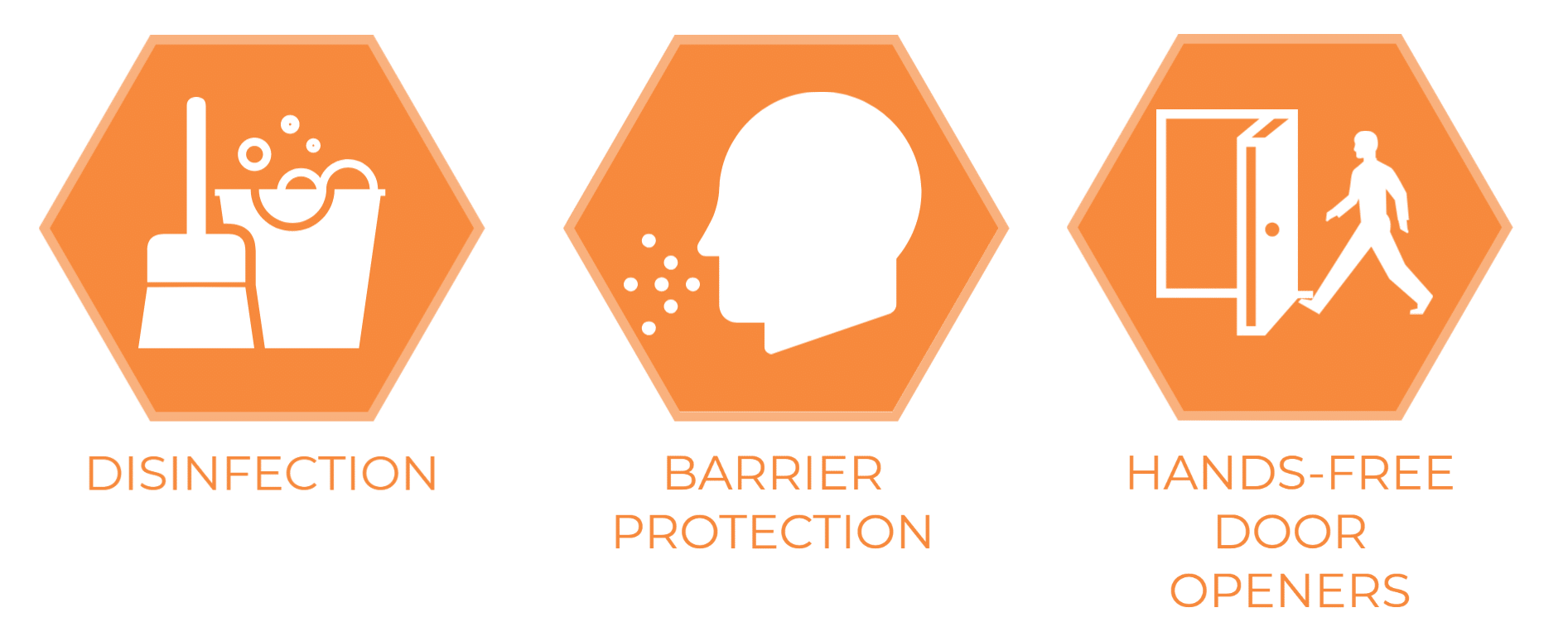Cleaning, disinfecting, sanitizing, sterilizing, decontaminating – there are so many different words for removing germs to help stop the spread of COVID-19, but they don’t all mean the same thing. As best practices and protocols are being developed for the eventual reopening of retail stores and other public spaces, it’s important to know how to properly clean a myriad of items that employees and customers will encounter.
Damage can be an expensive and frustrating result of improper care or cleaning, so it’s crucial that employees are knowledgeable on cleaning and disinfecting protocols for the various items within a space. For example, some companies are experiencing thousands of dollars in damage a day to their EFT and POS systems from simple spray disinfectants. A solution for these items is to install protective guards or clean with a 70% alcohol wipe.
When reopening locations, the first step in this new normal is to re-evaluate your existing cleaning program and be sure you’re aware of all CDC disinfecting rules.
Know the Difference
First, know the difference between cleaning, disinfecting and sanitizing.
Cleaning removes germs, dirt and impurities from surfaces or objects. leaning works by using soap (or detergent) and water to physically remove germs from surfaces. This process does not necessarily kill germs, but by removing them, it lowers their numbers and the risk of spreading infection.
Disinfecting kills germs on surfaces or objects. Disinfecting works by using chemicals to kill germs on surfaces or objects. This process does not necessarily clean dirty surfaces or remove germs, but by killing germs on a surface after cleaning, it can further lower the risk of spreading infection.
Sanitizing lowers the number of germs on surfaces or objects to a safe level, as judged by public health standards or requirements. This process works by either cleaning or disinfecting surfaces or objects to lower the risk of spreading infection.
Disinfecting Soft Surfaces
Soft surfaces, often overlooked during the sanitizing process, hold germs just the same and should be added to your cleaning program.
- Launder items, if possible
- Store non-essential items elsewhere, is possible
- Clean with soap and water
- Disinfect with EPA-registered household disinfectant
- Use a hydrogen peroxide-based disinfectant
Disinfecting Sneeze Guards
Sneeze guards are probably the newest addition to the space. Understanding how to properly clean them is important. If your sneeze guard is plexiglass or acrylic, here are some crucial cleaning tips.
- Do use a soft, clean cloth to remove dust first
- Do use a peroxide-based solution that is less than 40% peroxide
- Do use mild soap and water if other cleaners aren’t available
- Don’t use acetone, bleach or solvent-based cleaner
Let Powerhouse Be Your Solution
From installing recommended barriers and hands-free door opening solutions to disinfection cleaning services, Powerhouse is here for you. For many of our customers, we’ve moved from plan to execution in a matter of days in response to OSHA and CDC safety recommendations. We understand that health and safety is the highest priority, acting with a sense of urgency ensuring initiatives are completed as quickly as possible.
COVID-19 Services:
- Barrier Protection Installs
- Base Exterior Maintenance Programs
- Dark and Idle Property Security Protocols
- Dining Room FFE Reconfiguration/Storage
- EPA Registered Disinfectant Surface Treatments
- Hands-Free Door Opener Installs
- Limited Service Exterior Maintenance
- Location Reopening Support
- Vacant Space Boards-ups
Sources: https://www.cdc.gov/coronavirus/2019-ncov/prevent-getting-sick/disinfecting-your-home.html https://www.michaelsglassco.com/maintaining-replacing-sneeze-guards/ https://www.cdc.gov/infectioncontrol/guidelines/disinfection/index.html https://www.cdc.gov/flu/school/cleaning.htm https://www.epa.gov/pesticide-registration/list-n-disinfectants-use-against-sars-cov-2


